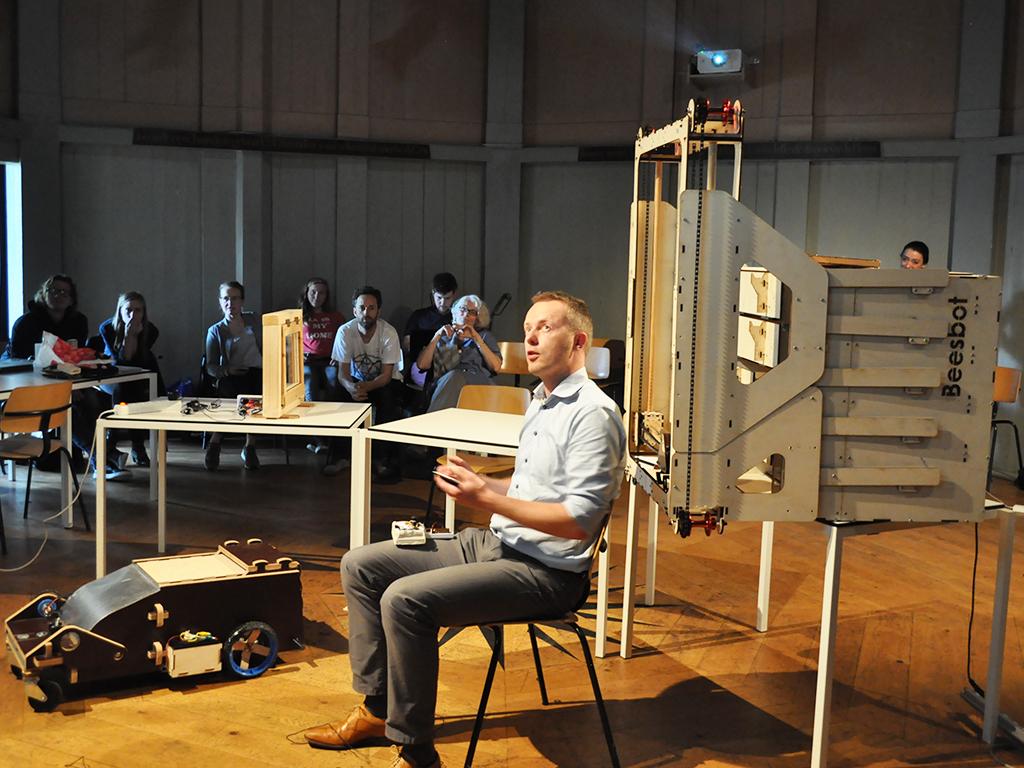Waag proudly presented another group of Fab Academy students and their final projects. In an intense six month program, the participants created projects such as the Leafbot, a robot that collects leaves from the ground, and the Item Watchman, that notifies you when leaving items behind in public. Last week, makers from Japan to Alaska presented their final project to their fellow Fab Academy students across the world via a live video conference, and luckily non were kept by the time difference.
How to make (almost) anything
In total over fifty Fab Labs from around the world tuned in to present their creations via webcam. In the Fab Academy program, students from the international network of Fab Labs work together via online video collaboration. Fab Academy provides hands-on training for designing and fabricating smart systems by using techniques such as 3D printing, laser cutting, working with sensors, actuators or (wireless) communication. Fab Academy originates from the MIT's Center for Bits and Atoms, where Neil Gershenfeld opened the first Fab Lab. Throughout the program, Gershenfeld gives lectures, feedback, and suggestions on the further development of the students projects via live video connection.
Fablab Amsterdam
From the Fab Academy Amsterdam, six students presented their final projects. For her project Angelou, Eva Korae built a foldable stool bear that speaks as soon as someone sits down on it. Sander van Vliet made a CO2 responsive window control system, that regulates the carbon dioxide level in a house. The third student, Sebastiaan Moes, was frustrated with spending all his Saturdays picking up oak leaves in his garden and developed Leafbot: a robot that collects leaves from the ground. Paul Gröneveld made steps in innovative beekeeping and build a automated beehive to optimize the process. Another practical final project was the Item Watchman by Shunichi Mizugaki which notifies you when leaving items behind through bluetooth or alerts you with a accelerometer when items are close to being snatched. Finally, Marije Kanis created a verbal hand grenade against bureaucracy with her project: Bureau-crazy. The project entails a wall and a cabinet which reacts in an endless loop by pointing you to either the wall or the cabinet. Its modular design is a physical way to fight against bureaucracy and is meant as an ‘award’ for people guilty of bureaucracy.
If you want to make something, just go do it
Waag’s Emma Pareschi, a former Fab Academy student herself, guided the students during the program. Emma stated that most of the participants follow the program parallel to their jobs and therefore dedicated all their free time and energy to the program. Student Paul Groneveld expressed that learning how mechanics work, and realizing that these techniques are actually accessible for everyone is one of the great findings for him as a teacher. Besides mechanical skills the students thrived cause they proved themselves to be able to make anything they want. Or, as Sebastiaan Moes concluded his presentation: ‘If you want to make something, just go do it.’
Students documented their work process and findings, enabling others makers to learn from their experiences too. The final projects and documentation will be reviewed after which a graduation ceremony will take place from the FAB12 conference in China. After receiving their Fab Academy Diploma, students have stated to continue with applying and understanding techniques in their daily life, while others are dedicated to contribute to the global Fab Lab network and inspire others with their experiences.
Fablab Amsterdam has organized the Fab Academy since 2009 and is planning on getting many more students involved. Are you interested in learning how to make use of the tools and machines in any Fab Lab and broaden your (mechanical) knowledge? More information on next years Fab Academy program will be available on the international Fab Academy website.



